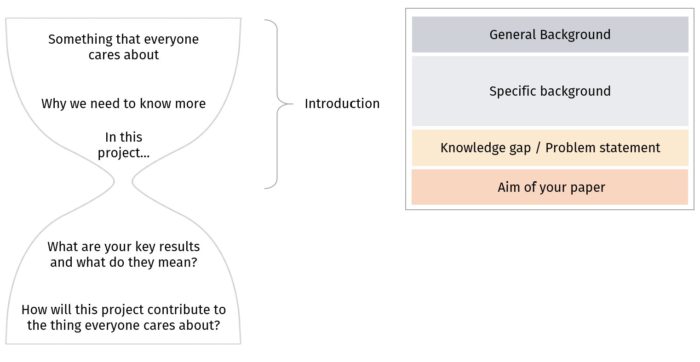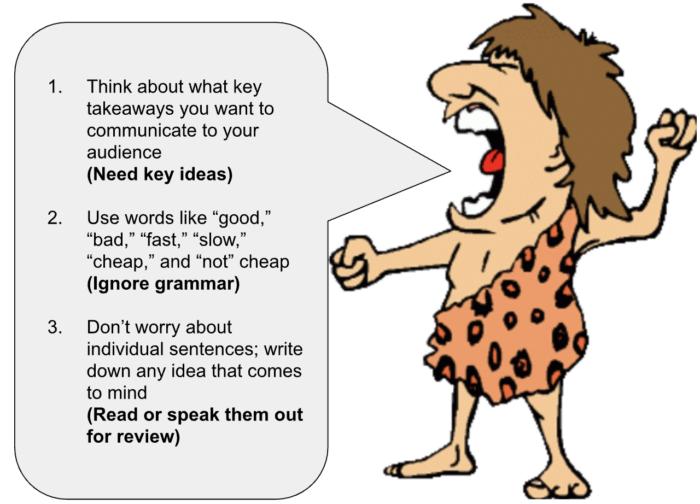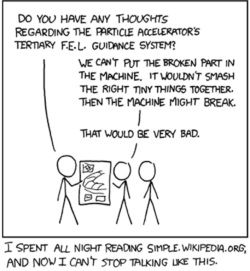Why Cave Rave?
Brainstorming can be difficult, and I often find clients (and myself) focusing so much on what each sentence should say that we lose track of what our communication medium is trying to convey. Additionally, the brainstorming process is usually writer-focused, i.e. done with the writer’s concerns rather than the audience’s in mind. Conversely, the hourglass approach[1] gives a solid foundation to write with a high-level impact and low-level specificity. In short, the hourglass approach ensures we augment our work with context and importance so that the audience can better follow and appreciate what you are doing. This audience-focused tool provides a link between the high-level impact stated initially and how your specific work addresses the impact.

The Hourglass approach from https://mitcommlab.mit.edu/nse/commkit/journal-article-introduction/
However, in the beginning of the writing process, even organizing your ideas into an hourglass can seem daunting. A way to distill a brain dump into its key points could enable a reader-focused version of brainstorming—a version more focused on what we actually mean rather than what exact words we should say. I typically formulate these simple key points (from my brain dump) when preparing for a pitch or presentation, allowing me to improvise while still sounding coherent. By simplifying the words we use to describe our writing, I believe we can more easily push through writer’s block and refine our writing’s high-level structure more quickly. Relying on simple words even a “caveman” could understand, I coined this process the “Cave Rave” approach.
What the Cave Rave approach is:

Image modified from: https://clipartspub.com/images600_/cave-man-clipart-transparent-background-6.png
You can do this on paper or by speaking out loud, whichever is easier for you! So what does “Cave Raving” look like in practice?
Here’s an example about my research on designing new materials for fusion power plants:
- Fusion good for green energy
- No good material to make fusion cheap
- Make new material take long time
- We have no time
- I work make framework
- Framework make new material fast
- Fusion can then be on grid soon
- Yay green energy
This took me ~30 seconds to put together and has a relatively coherent hourglass approach. It’s “good enough” to structure a narrative, highlight our key claims, and begin the writing process.
What comes after Cave Raving?
With the Cave Rave approach, you have likely already handled the high-level message of your work. In a way, you have decoupled the need to think about the high-level meaning and low-level execution of writing! In other words, you are now ready to improve the specificity of each sentence individually. Let’s take a look at how my cave rave can be elevated.
- Fusion power can enable the green energy transition.
- Its economic viability is now limited by the lack of capable structural materials available.
- The current nuclear materials design process can take more than 20 years, but fusion needs to be deployed by the end of the decade.
- The focus of this PhD is to combine simulations where possible and experiments when needed to quickly down-select through the composition and processing space within a material family.
- By comparing the relative performance of materials within their family, we can more quickly infer a material’s thermo-mechanical performance and how radiation will change it.
- The successful implementation of this nuclear material design framework can assist in making fusion cheaper and more robust, as well as the backbone of the green energy transition we need next decade.
By repeating the cave rave mantra for each sentence, it was easier for me to focus on what I needed to convey with my words. While not perfect, we now have a focused beginning to a thesis abstract.
How can you use Cave Raving moving forward?
So where can you use the Cave Rave approach in your work? I’ve found it helpful when preparing for presentations, writing an abstract or paper, designing a pitch, and even planning for a research project.
To dive deeper:
- For a recent presentation, I used “Cave Rave” talking points and slide titles to quickly practice my content delivery and hone my central message.
- The cave rave example I used previously in this blog post helped me write my thesis prospectus.
- I’ve encouraged FUSars[1] seminar students to Cave Rave their 90 second research pitches that they’d give to donors. These Comm Lab appointments were when I actually began working on the Cave Rave process.
- I’ve even used the Cave Rave approach to more clearly design clear and achievable projects for my UROPs (undergraduate researchers).
The Cave Rave approach lowers the friction of the brainstorm process and can help you more clearly define what your work or project actually needs.
In summary:
|
[1] A more intensive undergraduate research and learning opportunity with an expectation to produce peer reviewed level research with its completion – https://www.psfc.mit.edu/fusars
Myles is a graduate student and former undergraduate in NSE. He is also a Communication Fellow. He is co-advised by Prof. Mike Short and Prof. Dennis Whyte.
Published October 6, 2023
Related articles and resources:
- Journal Articles: Introduction
- Elevator Pitch
- Simple Writer (XKCD)
- De-jargonizer (Jargon Project)
- Simple Wikipedia

